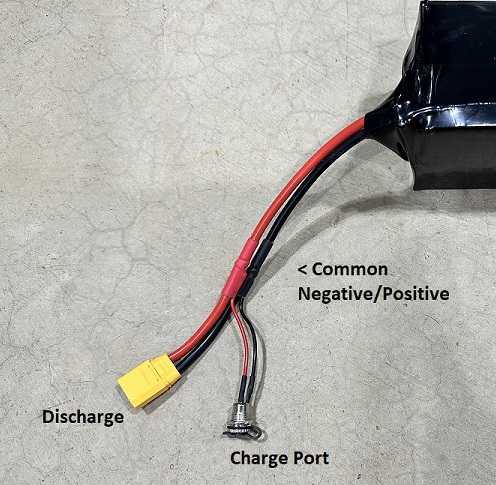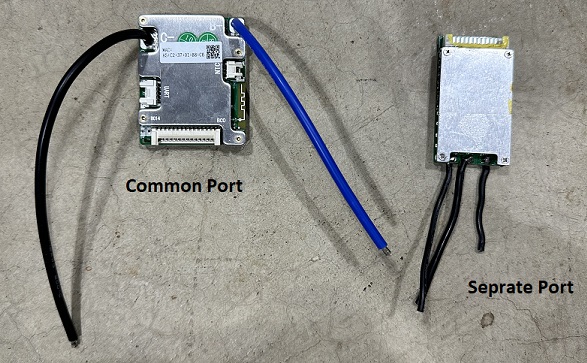
What Does Common Port BMS Mean?
Table of Contents
A common port BMS means that charging and discharging are handled by the same port on the Battery Management System board.
Common And Separate Port BMS Differences
The main difference between common port and separate port BMS is how their charge ports are wired. In a common port BMS, the same port is responsible for both charging and discharging the battery. An easy way to see if a BMS is a common or a separate port is that a separate port will have P and C connections and a common port will not. You could, in theory, establish a dedicated charge line on a common port BMS.
However, this line is simply a different physical pathway returning to the same electrical point as the discharge port. In contrast, a separate port BMS has independent charge and discharge points controlled by the same type of MOSFETs (Metal-Oxide-Semiconductor Field-Effect Transistors) found in a common port BMS, but in a different configuration.
Separate Port BMS: Independent Control
A separate port BMS offers more complex control over charging and discharging through a larger amount of MOSFETs. You'll find a large array of these transistors controlling the discharge process, while only a small number manage the charge. They function independently, offering a higher level of control over charge and discharge. This feature proves beneficial in specific systems, like DIY powerwall setups, where you might need the battery to keep charging even if the voltage drops to a point where discharging is unsafe.
However, it's crucial to note that this level of control is unnecessary for most applications. For instance, in an e-bike, charging and discharging never occur simultaneously, making a separate port BMS redundant.
Is A Common Port BMS Better?
The simplicity of the common port BMS is one of its major advantages. When building a battery with a common port BMS, you have the option to wire just one set of cables to your battery. With a separate port BMS, you have to run full charge and discharge lines, but because a common port BMS handles charge and discharge on the same port, you can opt to only connect a single set of cables to the battery, and then place a charge connector on the end of the discharge cable.
Due to how their transistors are arranged, common port BMS can often handle a lot more charge current than their separate port counterparts. This fact alone in our opinion makes common port-type BMSs the best BMS to go with.
[[ aff type=cta ~ bg=`` ~ main=`Guided BMS Picker` ~ second=`Need help picking the best BMS, use the tool found at the link below to get guided to the correct BMS. ` ~ btnText=`BMS Picker` ~ btnLink=`https://cellsaviors.com/bms-picker` ~ align=`center` ]]
Is A Common Port BMS Better Than A Separate Port BMS
In most cases, they are. One significant drawback of a separate port BMS is its limited charge current capacity. This is due to the fewer number of MOSFETs handling the charging process. Common port BMS, on the other hand, typically feature a symmetrical or larger number of charge MOSFETs, enabling them to handle higher charge currents.
Also, separate port BMSs are often less reliable than their common port counterparts. One leading theory attributes this to the low charge current that they can handle, as most failure modes related to separate port BMS involve the battery no longer taking a charge.
A common port BMS is also easier to install and wire than a separate port BMS, as less connections to the BMS need to be made.
Real-World Applications of BMS Type
When it comes to real-world applications, a common port BMS has a range of uses that span different industries. Here are two examples:
Light Electric Vehicles (LEVs): LEVs like e-bikes and scooters typically require a high level of energy efficiency and safety, and a common port BMS can offer this. By allowing charging and discharging through the same port, a common port BMS simplifies the wiring and reduces the risk of incorrect connections, which can potentially lead to malfunctions or even hazards. It also typically offers a higher charging current, which can shorten charging time—a critical factor for EV users.
DIY Battery Storage Systems: Solar power storage systems often use batteries to store energy for use during the night or cloudy days. In these systems, a separate port BMS makes more sense, as it allows for the independent control of charge and discharge. If your system’s battery is depleted, you don’t want charging to be cut off during the already small time window that your solar panels can get a good amount of direct sunlight.
Pretty Much Anything: Common port are easier of the two BMS to install on a battery and easier to understand than a separate port BMS. Your car battery doesn't need separate charge and discharge lines, solar panels don't have separate input and output lines, etc, so why should anything else? There are little to no disadvantages of using a common-port BMS, other than edge-case dual charging and discharging scenarios that are impractical for nearly all applications other than home energy solutions.
Economic Considerations of BMS Type
While the initial cost of a common port BMS might be slightly higher than a separate port BMS, this is usually offset by several factors.
Simplified Installation: As mentioned earlier, a common port BMS requires less complex wiring, which can reduce installation costs. It also tends to be more reliable, reducing the frequency of maintenance and potential replacement costs.
Higher Current Capacity: The higher charging current capacity of a common port BMS can mean faster charging times. In commercial applications, this efficiency can translate into significant cost savings over time. For example, an electric vehicle fleet would benefit from shorter charging times and less downtime.
Generally Lower Operating Temperature: Because they support much higher charging currents, a common port BMS will maintain a lower temperature during charging compared to a separate port BMS with the same discharge rating.
While a common port BMS is generally more straightforward, some sophisticated variants have emerged that can independently control the charge and discharge processes. These high-end, smart BMSs are usually equipped with advanced software, control logic, and even Bluetooth adaptors. However, these features come at a higher cost and are typically reserved for high-current systems.




